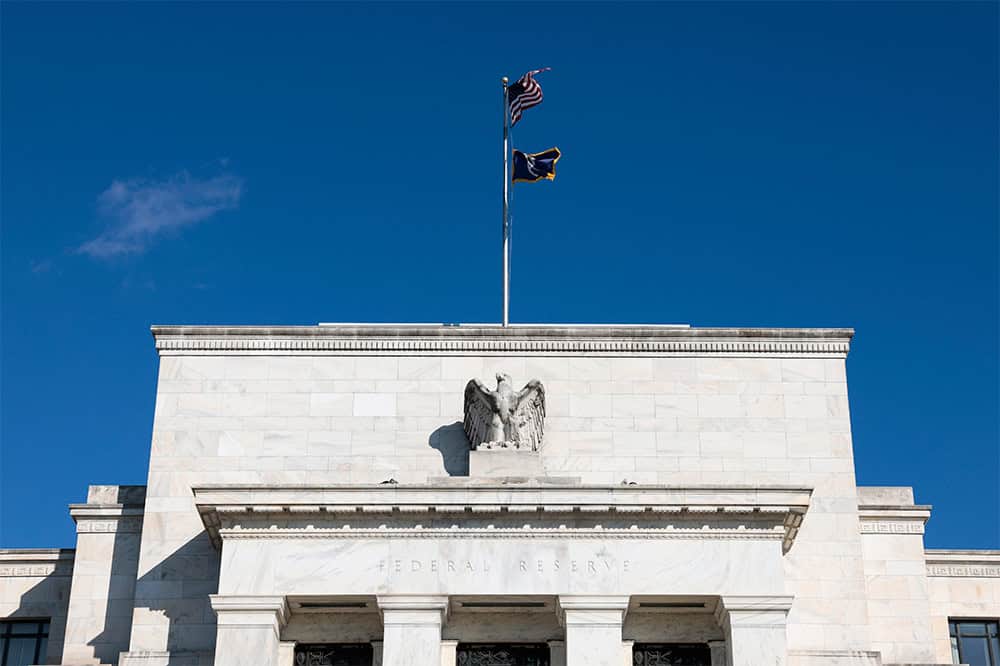CBO: Unsustainable Deficits Threaten Future Economic Growth
Last Updated June 29, 2017
With Congress considering a range of policy reforms that could have significant fiscal costs, the nonpartisan Congressional Budget Office (CBO) warns in a new report that America faces serious budgetary challenges that threaten our future economy. On our current path, CBO projects that deficits will reach $1.0 trillion by 2022 and total $10.1 trillion over the next ten years.
In the new report, CBO projects that:
- The budget deficit will total $693 billion this year — $255 billion higher than it was just two years ago.
- The deficit will exceed $1 trillion annually by 2022, and will remain above $1 trillion permanently unless policies are changed.
- The national debt will climb significantly over the next ten years, reaching 91 percent of gross domestic product (GDP) in 2027— more than double the 50-year historical average.
- Interest costs on the debt will rise sharply and become the third largest “program” by 2026. Over the next ten years, net interest will total $5.6 trillion.
- These near-term increases in deficits and debt are the result of a structural long-term imbalance between spending and revenues. In the coming decade, we will begin to see these structural problems take hold, and for the first time will enter into a period where deficits will increase and accelerate permanently, with no end in sight.
CBO warns that this structural imbalance puts our economy at risk over the long-term:
“Such high and rising debt would have serious negative consequences for the budget and the nation:
- Federal spending on interest payments would increase substantially as a result of increases in interest rates, such as those projected to occur over the next few years.
- Because federal borrowing reduces total saving in the economy over time, the nation’s capital stock would ultimately be smaller, and productivity and total wages would be lower.
- Lawmakers would have less flexibility to use tax and spending policies to respond to unexpected challenges.
- The likelihood of a fiscal crisis in the United States would increase."
The federal deficit will grow significantly over the next ten years
CBO projects that the budget deficit will climb from $693 billion in 2017 to $1.5 trillion in 2027, resulting in a cumulative 10-year deficit of $10.1 trillion. Deficits are projected to decline temporarily during the next two years due to the timing of certain payments, but the overall trend in the deficit is unmistakable — it more than doubles over the next decade.
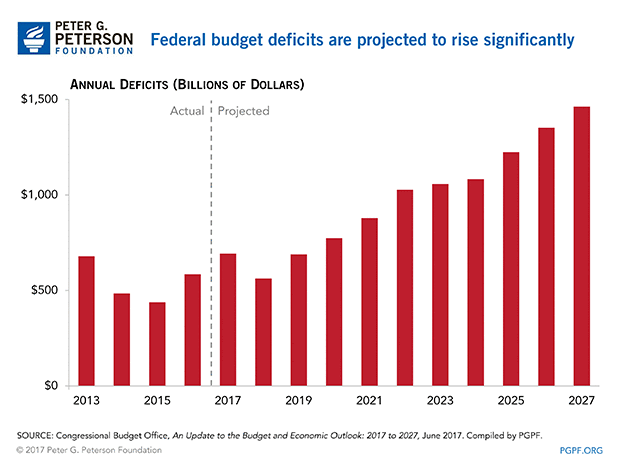
Importantly, while rising deficits during the Great Recession were due to the economic slowdown, the rising deficits over the next 10 years stem from a structural mismatch between spending and revenues. Over the next 10 years, CBO estimates that revenues will rise slightly from 17.3 percent of GDP in 2017 to 18.4 percent of GDP in 2027. Spending, however, is expected to rise significantly over the same period, increasing from 21.0 percent of GDP in 2017 to 23.6 percent in 2027. CBO projects that total federal spending will equal $53.1 trillion over the next 10 years, while total federal revenues will total only $43.0 trillion. Over the long term, this gap will continue to widen even further.
There are two major drivers of noninterest spending in the federal budget: the aging of the population and rising healthcare costs per enrollee. The aging of the population is the result of baby boomers entering retirement and people living longer. The number of people aged 65 and older is projected to increase from 50 million in 2017 to 68 million in 2027. These demographic trends will put significant pressure on the federal budget by driving up spending on mandatory programs that primarily serve older populations, such as Social Security, Medicare, and Medicaid.
Growing healthcare costs per enrollee is the second major driver of spending. Although the overall growth of these costs had slowed in recent years, some of this slowdown in growth may have been due to a weak economy following the recession, rather than permanent inefficiencies in the healthcare sector. CBO incorporated that slowdown into its projections. However, even after accounting for that slowdown, CBO still projects that net spending on our major healthcare programs will climb sharply — by 85 percent over the next 10 years —from $1.0 trillion in 2017 to $1.9 trillion in 2027.
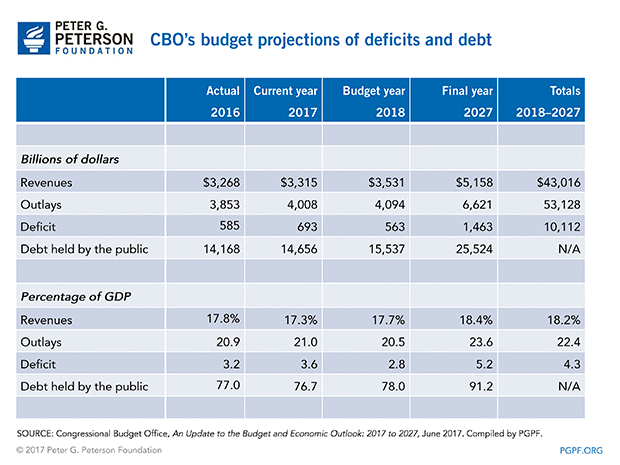
Federal Debt Reaches Historically High Levels
CBO projects that federal debt will climb to 91 percent of GDP in 2027. Historically, that is a very high level of debt. Since 1790, there have only been four years in which the debt was above 85 percent of GDP, and those were during and just after World War II. After the war, debt began to fall sharply as a share of GDP as the economy grew and some debt was paid down. Today, the budget outlook is much more worrisome because projections show a more permanent and dramatic increase in debt not due to a temporary war but because of growing spending on mandatory programs and interest, coupled with inadequate revenues.
Interest Costs: The Fastest Growing Major Item in the Budget
As debt continues to accumulate and compound, and interest rates increase, net interest costs are projected to more than double over the next decade, increasing from $269 billion in 2017 to $818 billion in 2027. Over the next 10 years, interest costs will total $5.6 trillion. As they grow, interest costs will crowd out important investments in our future that fuel economic growth, such as infrastructure, R&D, and education.
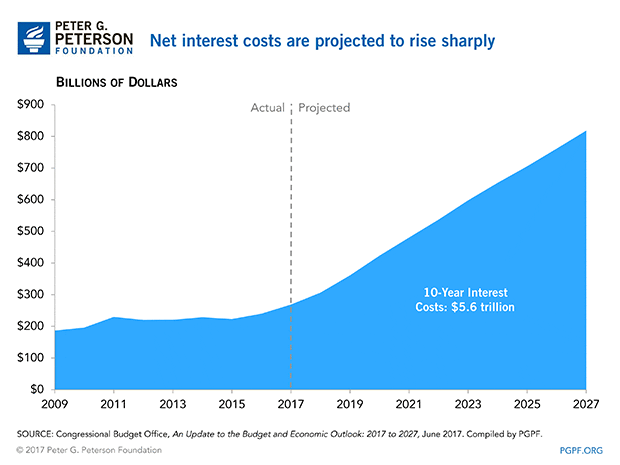
The Federal Reserve has recently begun to tighten monetary policy by raising interest rates. In June 2017, the Fed increased its benchmark interest rate on federal funds by another 25 basis points, the fourth time since the end of the Great Recession. CBO forecasts that the interest rate on 3-month Treasury bills will climb from 0.9 percent in 2017 to 2.8 percent in 2027.1 Interest rates on 10-year Treasury notes are projected to increase from 2.4 percent in 2017 to 3.7 percent in 2027.
Mandatory Spending is Projected to Climb in the Coming Years
Mandatory spending (excluding net interest) is projected to increase from $2.5 trillion in 2017 to $4.3 trillion in 2027, due primarily to demographics and our nation’s inefficient healthcare system.
-
- Major Health Care Programs: CBO projects that net spending on the major healthcare programs will climb from $1 trillion in 2017 to $1.9 trillion in 2027. That increase reflects the growth of three major programs:
- Medicare: With the aging of the population and an increase in costs per beneficiary, net spending for Medicare will grow by 96 percent, rising from $590 billion in 2017 to nearly $1.2 trillion in 2027.
- Medicaid: Medicaid spending is expected to increase by 70 percent, rising from $385 billion in 2017 to $655 billion in 2027.
- Exchange Subsidies: Spending on subsidies to help people purchase health insurance on the exchanges created by the Affordable Care Act is projected to double from $51 billion in 2017 to $106 billion in 2027.
- Social Security: Spending on Social Security, currently the largest federal program, will grow by 78 percent, rising from $939 billion in 2017 to $1.7 trillion in 2027, driven primarily by the retirement of the large baby boom generation.
- Major Health Care Programs: CBO projects that net spending on the major healthcare programs will climb from $1 trillion in 2017 to $1.9 trillion in 2027. That increase reflects the growth of three major programs:
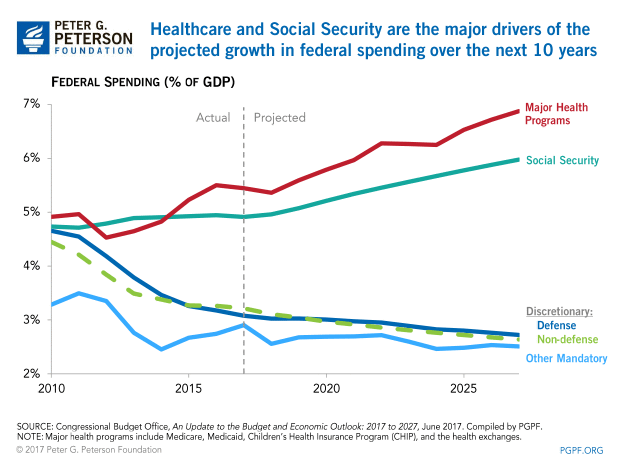
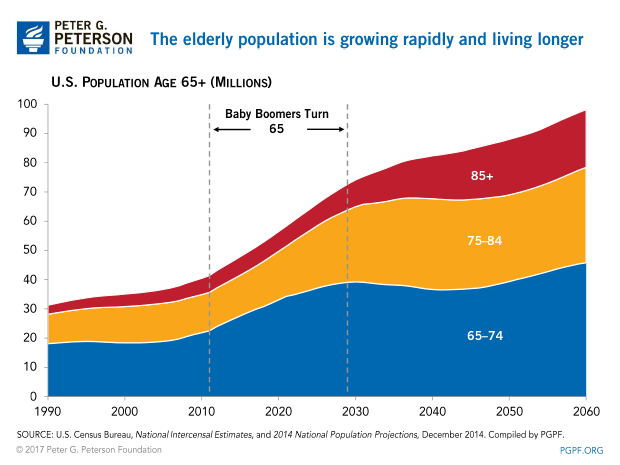
Discretionary Spending Is Projected to Decline
As spending on mandatory programs and interest costs continues to rise, federal spending on discretionary programs will decline from 6.3 percent of GDP in 2017 to 5.4 percent in 2027. This would be a historically low level of discretionary spending — 25 percent below its 20-year historical average. Discretionary spending funds a wide range of programs including defense, education, research and development, infrastructure, and a variety of other programs.
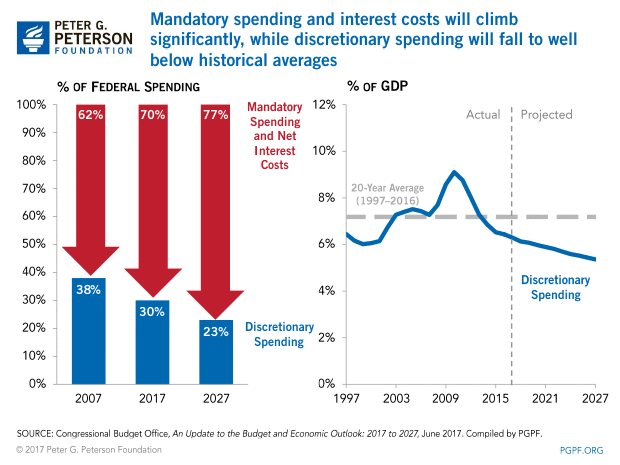
The Time for Policy Makers to Act Is Now
CBO’s new report provides yet another stark warning that our nation’s fiscal outlook is unsustainable and dangerous.
CBO projects that by 2047, debt held by the public will reach an unprecedented 150 percent of GDP. This growing debt reduces our ability to invest in the future, gives us less flexibility to respond to unexpected challenges, and increases the risk of a fiscal crisis.
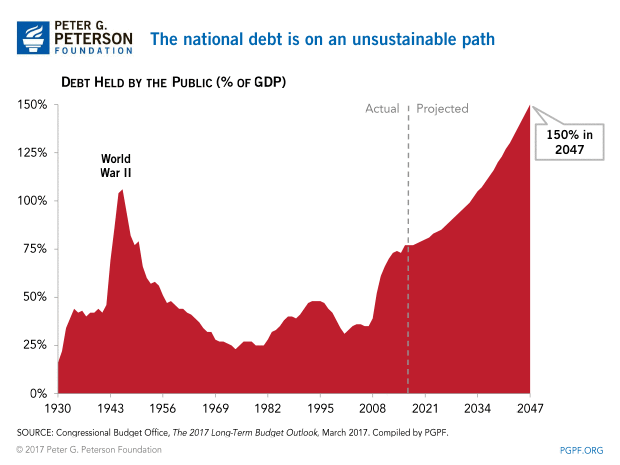
The Administration and Congress are considering a range of proposals across a number of important policy areas including healthcare, tax reform, infrastructure and more. Given the unsustainable projected growth of our national debt, these new reforms should result in improvements to our fiscal outlook. Lawmakers should use this opportunity to enact sensible reforms that put our nation on a sustainable fiscal path. To ensure that reforms will be durable, lawmakers should work together and across party lines to build a strong fiscal foundation for our economy and for future generations of Americans.
1 Forecasts of interest rates are based on calendar years. Forecasts of budget data are based on fiscal years, which is from October 1 to September 30.
Photo by Alex Wong/Getty Images
Further Reading
Growing National Debt Sets Off Alarm Bells for U.S. Business Leaders
Debt rising unsustainably threatens the country’s economic future, and a number of business leaders have signaled their concern.
What Is R Versus G and Why Does It Matter for the National Debt?
The combination of higher debt levels and elevated interest rates have increased the cost of federal borrowing, prompting economists to consider the sustainability of our fiscal trajectory.
High Interest Rates Left Their Mark on the Budget
When rates increase, borrowing costs rise; unfortunately, for the fiscal bottom line, that dynamic has been playing out over the past few years.


